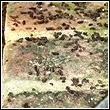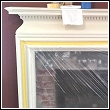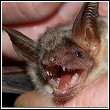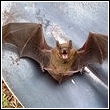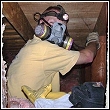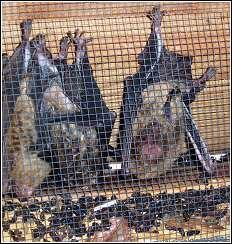
Identifying A Bat Problem
Sounds In The Attic
Calls to us regarding bat problems usually start coming in during the middle of the winter - these calls are almost always big brown bats.
Big brown bats "wake up" in the middle of winter warm spells sometimes, move around in the attic, and stumble into living quarters or offices.

The above photo was taken of some bats The Wildlife Whisperer encountered at a client's home - "hanging out" on their attic screen. It helps illustrate how ineffective methods can sometimes actually make a problem worse. The screen was meant to help keep animals out, but instead it gave them a place to "hang out" instead. Note the guano piling up on the ground beneath them.
Signs Around The House
Some of the signs of bats to look for around your home or business include bat feces, also called guano, and grease marks on buildings.
Look for feces on the ground inside or outside your home, and marks toward the roof where the bats might be entering and exiting the attic.
The photos below are examples of signs that indicate bats around your home. The guano on the left was found on the insulation in an attic. The marks to the right are the results of the bats bodies producing "grease" and leaving it on the surface where the bats enter and exit the building.
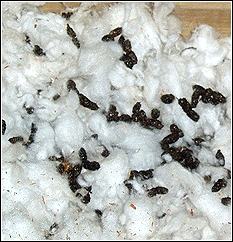
in attic insulation
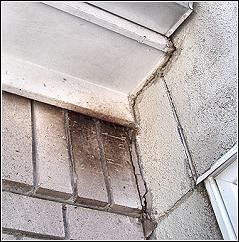
are going in and out of a home
Bats love hanging out behind window shutters too, and often settle in behind them. Bats have a tendency to squeeze their way into some pretty interesting places, consequently, signs of guano and grease marks may not always be limited to the attic or upper level areas of your home.
Identifying Guano
If you find "mouse droppings" by your door, it may be bat guano. Every year we receive an incredible number of calls with complaints about mouse droppings outside of people's homes and businesses. However, upon investigation these droppings frequently turn out to be bat feces.
Bat feces is called guano. Imagine for a moment, (because most people don't want to do it), picking up a handful of this guano and gently crushing it in the palm of your hand. If this is done outdoors under sunlight you will see hundreds of sparkly and shiny things in the droppings. This is because Guano primarily consists of the hundreds and thousands of insects bats consume every evening. The shiny things you see are insect eyes and wings; and it helps illustrate why we say bats outside are good.
Indicators Of Feeding Roost
And Free Roosting Bat Problems
People often tell us "I see bat guano on the ground but not the bat". In such cases, if you find bat guano on the ground or on your deck and you look up and do not see the bat, this is referred to as a "feeding roost".
A feeding roost is a location desirable for bats to come to on a nightly basis to digest their food, urinate, defecate and leave by dawn.
A free roosting bat is one that likes to hang around various areas around your home in search of a warm, cozy spot to shelter and roost.
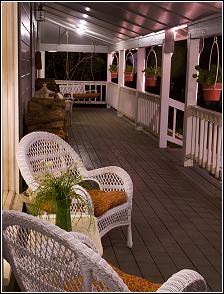
The most common area for bat guano to be seen for the first time by home owners will be underneath wall mounted speakers in the corner of their front or back porch, as well as behind shutters and outdoor televisions. These areas are dark and cozy, and a perfect place for a bat to tuck itself away snug and secure during the daytime hours.
Odors Inside Your Building
Bat urine can sometimes be seen on the outside of a building, on attic rafters and elsewhere around the house. This bat urine is typically going to look like a splash of milk leaving a white, barely visible residue. It contains ammonia and can certainly be described as having an odor.
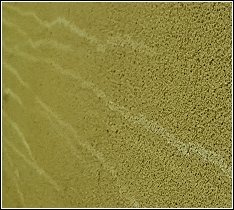
For the most part, guano droppings dry quickly and by themselves seldom create an odor. But, when given time to accumulate, bat guano combined with urine will start to smell like ammonia under the right conditions.
Basically the smell that is recognized as bat guano is actually not from the guano, but rather from the ammonia in the urine instead.
In other words, you may not have an odor in your home, but that doesn't mean the bats aren't there, it may merely mean the guano and urine have not yet had a chance to pile up enough to start to smell.
Of course, if you do have an odor, similar to a nasty cat litter box and you don't have a cat or anything else that may be causing it - then that could indeed be an indicator in and of itself. And it may also mean that you have a large colony of bats and/or one that has been in place for a long time.
Once you have determined you have a bat problem you will want to take action immediately. Even when the season is not right for evicting bats you will want to start preparations for removal and take interim safety steps right away. There are a lot of things that can be done while you are waiting for the proper season to arrive. Acting now will help eliminate the chance that your area bat control companies will be fully booked and unable to help you once the proper season arrives.
It is important to note that guano can be hazardous to your health so you will also want to consider a clean up plan. And it will be important to follow safety procedures when encountering bats to avoid bites and rabies.
For the most part, bat control is a complex process that can become hazardous quickly, so you will want to seek the help of a professional from start to finish - for all your bat removal, exclusion and clean up needs.
1242 SW Pine Island Rd., Suite 310
Cape Coral, Florida 33991-2126
help@totalwildlifecontrol.com




